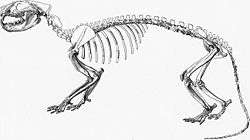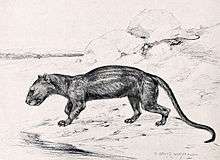Oxyaena
| Oxyaena Temporal range: Late Paleocene–Early Eocene | |
|---|---|
 | |
| Oxyaena lupina skeletal restoration | |
| Scientific classification | |
| Kingdom: | Animalia |
| Phylum: | Chordata |
| Clade: | Synapsida |
| Class: | Mammalia |
| Family: | †Oxyaenidae |
| Subfamily: | †Oxyaeninae |
| Genus: | †Oxyaena |
| Type species | |
| Oxyaena lupina Cope, 1874 | |
| Species | |
| |
Oxyaena ("Sharp" or "Drawn-out" + hyena) is an extinct genus of oxyaenid mammal from the latest Paleocene to early Eocene of North America (most specimens being found in Colorado). The species were superficially cat or wolverine-like, with a flexible body 1 metre (3.3 ft) long, and short limbs. Some species like Oxyaena forcipata where bigger with a body mass estimated to be 20 kg.[1]

Oxyaena had a broad, low skull (20 cm. long) with a long facial part and a massive lower jaw, while its body and tail were long and its five-toed limbs were short.
Often compared to martens or cats, the Oxyaenids tended to have long bodies and tails with short legs. They most likely relied on their sight and hearing for hunting.
Unlike true cats, Oxyaena was plantigrade, treading on the whole surface of its soles.
It is presumed that Oxyaena was a leopard-like predator that could climb trees in search of prey.
References
- ↑ Gunnell, Gregg F., and Philip D. Gingerich. "Systematics and evolution of late Paleocene and early Eocene Oxyaenidae (Mammalia, Creodonta) in the Clarks Fork basin, Wyoming." (1991).
- Benes, Josef. Prehistoric Animals and Plants. Pg. 203. Prague: Artia, 1979.
- Gunnell, Gregg F., and Philip D. Gingerich. "Systematics and evolution of late Paleocene and early Eocene Oxyaenidae (Mammalia, Creodonta) in the Clarks Fork basin, Wyoming." (1991).